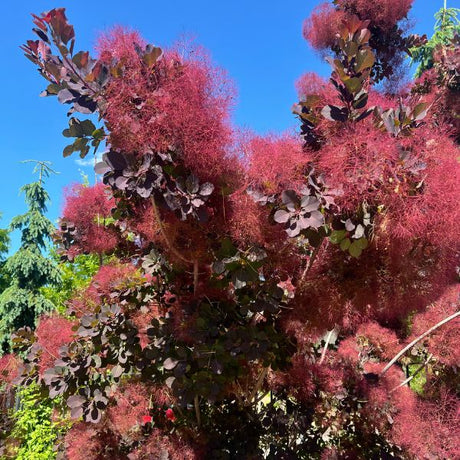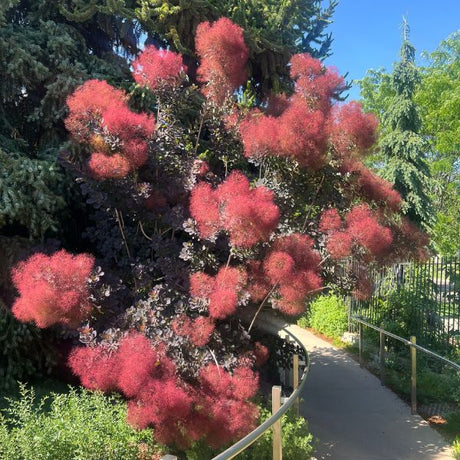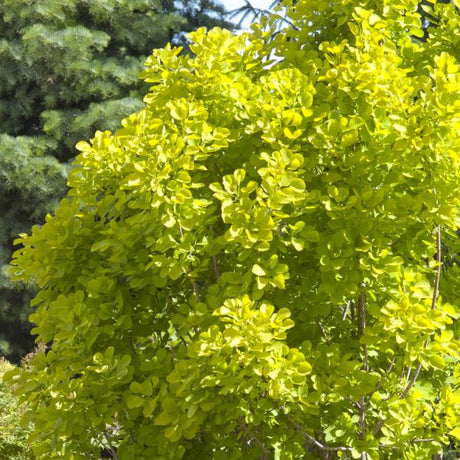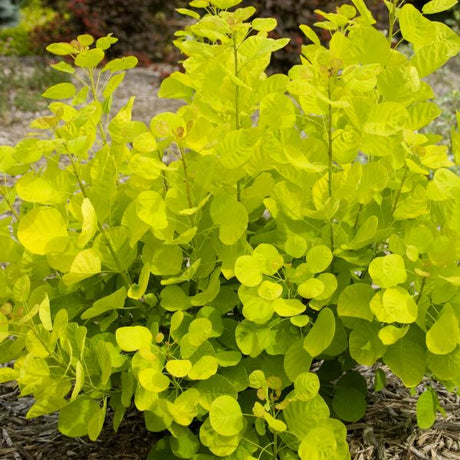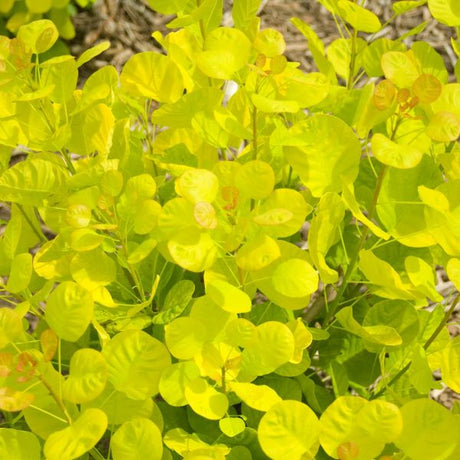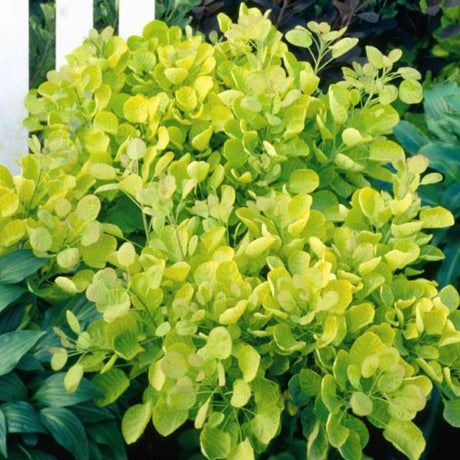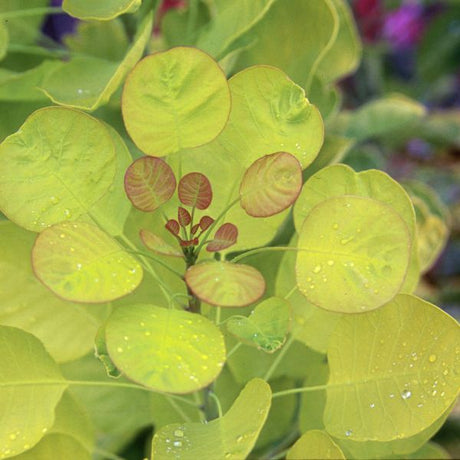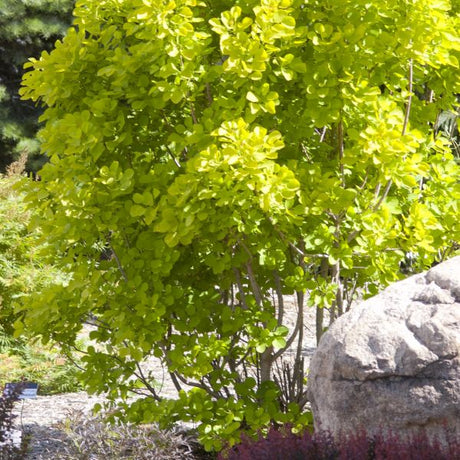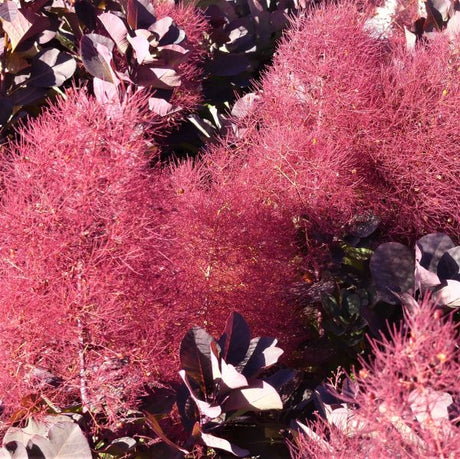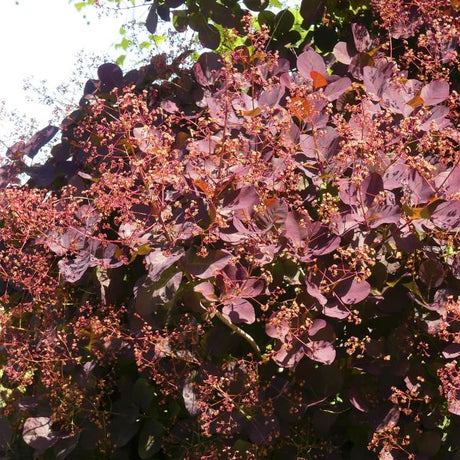- Sold out7% offSale price $19667 Regular price $21123Unit price /Unavailable
- Sold out
- Sold out
Smokebushes - Color & Curiosity For Your Garden!
 The Smokebush (or Smoketree) is a whimsical and colorful deciduous plant that will turn heads with its laundry list of curious characteristics!
The Smokebush (or Smoketree) is a whimsical and colorful deciduous plant that will turn heads with its laundry list of curious characteristics!
Named for its dramatic display of fluffy mist-like plumes, the Smokebush will earn itself a prominent place in your heart and landscape!
About The Smokebush
The American native Smokebush (Cotinus obovatus) can be found throughout the southern states and midwestern US, and some varieties are native to southern Europe and China (Cotinus coggygria) as well!
Dramatic spring foliage emerges with a burst of color that can range from purple, to red, to blue-green and chartreuse! Then transform into equally dramatic hues for the fall that will ignite the fall landscape.
 Cotinus species are multi-branched, deciduous, shrubby bushes or small trees. Ranging from dwarf forms to towering rounded specimens, Smokebush can have compact, irregular branching that is open and airy. The foliage can line the stems in bottlebrush-like form or in clumps separated by lengths of equally colorful bare stems, creating a Dr. Seuss-inspired form! When combined with the fluffy flowering display that appears at the ends of the branches - you gain a magical burst of whimsy!
Cotinus species are multi-branched, deciduous, shrubby bushes or small trees. Ranging from dwarf forms to towering rounded specimens, Smokebush can have compact, irregular branching that is open and airy. The foliage can line the stems in bottlebrush-like form or in clumps separated by lengths of equally colorful bare stems, creating a Dr. Seuss-inspired form! When combined with the fluffy flowering display that appears at the ends of the branches - you gain a magical burst of whimsy!
Smokebush is coveted for these fluffy plumes! These late-season smoke-like blooms remain on the plants until frost and have a light scent that draws you in! Pollinators too will flock to these tiny flowers that are almost lost among their airy bracts and flower branches.
The plumes are so dense and fluffy that the plant appears in a smoky haze of color. Once pollinated, the male shrubs keep their airy plumes and female shrubs develop little seeds that the songbirds adore! Add these blooms as filler to bouquets and décor!
Gorgeous Landscape Appeal
Impressive hedges and backdrops, the largest can be trained into small tree forms that have a huge ornamental impact and boost curb appeal in your landscape!
Create outdoor garden rooms, screen in seating areas, and envelop your home with colorful property division! Children's gardens become more whimsical, plus Rock Gardens and Cottage Gardens gain curiosity all season!
 Add pops of year-round color to foundations and throughout the garden as brilliant focal points anywhere in the sun to partial shade landscape.
Add pops of year-round color to foundations and throughout the garden as brilliant focal points anywhere in the sun to partial shade landscape.
These phenomenal smaller Smoke Bushes are perfect as container specimens on your patio, porch, or pool deck!
- American Smokebush and Cooke's Purple™ Smokebush are the largest at 20-30 feet
- Royal Purple Smokebush lights up your garden beds and borders
- Golden Spirit Smokebush displays chartreuse foliage and white mist-like plumes
- Velvet Cloak Smokebush has glossy reddish-purple foliage and a dense growth habit
- Winecraft Black® Smokebush is a dwarf shrub with dramatic dark foliage
- Dusky Maiden Smokebush may be smaller but acts as beautiful accents and hedges
Regardless of which you choose, you'll gain scented and easy-to-grow pollinator shrubs, bird-friendly food, nesting and shelter, and a unique plant that works beautifully in hedgerows, and shelterbelts, and to beef up the color spectrum of biodiverse mixed shrub border!
Easy Smokebush Care!
Cold hardy, disease and pest-resistant, and drought-tolerant, Smokebush provides incredible impact without asking for much in return!
- Full sun or partial shade - better color, denser growth, and more blooms in full sun
- Highly adaptable to many soil types, even rocky, sandy, and well-drained clay
- Withstand hot dry spots better than most shrubs
- Their foliage won't fade despite heat or sun
- Water new plants regularly using the Finger Test method
- Once established, Smokebush handle occasional drought just fine
- Smokebush grow well in a soil pH of 3.7 to 6.8
- Use a 3-4 inch layer of pine needle/pine bark mulch to maintain the acidic conditions
Order Your Smokebush Today!
FAQ's for Buying Smokebushes Online
What is a Smokebush and why is it called that?
What is a Smokebush and why is it called that?
Smokebush, also known as Smoketree (Cotinus), is a deciduous shrub or small tree named for its fluffy, mist-like plumes that resemble puffs of smoke. These unique blooms appear in late summer and add a whimsical, hazy effect that makes Smokebush a stunning focal point in the landscape.
Where do Smokebush shrubs grow best and how much sun do they need?
Where do Smokebush shrubs grow best and how much sun do they need?
Smokebush grows best in full sun to partial shade, with more vivid foliage color, denser growth, and abundant blooms when grown in full sun. These hardy shrubs thrive in USDA zones 4–9 and adapt well to a variety of soil types, including sandy, rocky, or well-drained clay.
Do Smokebushes attract pollinators or support wildlife?
Do Smokebushes attract pollinators or support wildlife?
Yes, Smokebush flowers attract pollinators such as bees and butterflies, while the seed-bearing varieties support birds with food and shelter. Their airy plumes, layered foliage, and branching form also contribute to biodiversity in mixed shrub borders and hedgerows.
What are some popular Smokebush varieties for landscaping?
What are some popular Smokebush varieties for landscaping?
Top Smokebush cultivars include ‘Royal Purple’ for its bold foliage, ‘Golden Spirit’ with bright chartreuse leaves, and dwarf forms like ‘Winecraft Black®’ and ‘Dusky Maiden’ for smaller gardens. Larger types like ‘American Smokebush’ and ‘Cooke’s Purple™’ can be trained into tree form for dramatic height and impact.
How do you care for Smokebush shrubs to keep them healthy?
How do you care for Smokebush shrubs to keep them healthy?
Plant Smokebush in well-drained soil and water regularly while young. Prune in late winter or early spring to shape or rejuvenate growth. Once established, they are drought-tolerant, pest-resistant, and require minimal upkeep. Use acidic mulch like pine needles to support optimal soil conditions.

